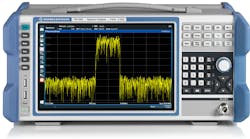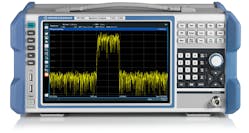Download this article in PDF format.
Spectrum analyzers are among the most useful of RF/microwave test instruments for their capabilities to display a wide dynamic range of signals within a large frequency range. The R&S FPL1000 spectrum analyzer from Rohde & Schwarz provides such an extreme measurement value in a diminutive unit that supplies the accuracy of a benchtop machine and the versatility of a battery-powered portable for measurements from 5 kHz to 3 GHz.
The FPL1000 spectrum analyzer shows measured signals on a bright, 10.1-in. touchscreen with 1280- × 800-pixel resolution (see figure). As many as six signal traces can be displayed at any one time, with as many as 1001 trace points. The standard displayed average noise level is −152 dBm, which can be reduced to −167 dBm with an optional preamplifier. The reference level can be set as low as −130 dBm plus the amount of added attenuation.
The spectrum analyzer captures signals within its frequency range using resolution-bandwidth (RBW) filters that can be set from 100 kHz to 10 MHz in a 1, 2, 3, 5 sequence (an option includes RBWs as narrow as 1 Hz). Signal traces can be displayed with impressive frequency resolution of 0.01 Hz. Sweep times range from as fast as 1 μs to as long as 8000 s for zero-span measurements.
The aging rate for the standard temperature-compensated crystal oscillator (TCXO) frequency reference is 1 × 10-6, while an optional high-stability oven-controlled crystal oscillator (OCXO) frequency reference can provide an aging range of 1 × 10-7. The analyzer has a standard in-phase/quadrature (I/Q) demodulation bandwidth of 10 MHz with an option for a 40-MHz I/Q demodulation bandwidth. Total measurement uncertainty is only 0.5 dB.
The R&S FPL1000 spectrum analyzer, with a measurement range of 5 kHz to 3 GHz, packs a great deal of test power into a compact package. (Courtesy of Rohde & Schwarz)
The flexible spectrum analyzer features outstanding spectral purity, characterized by low single-sideband (SSB) phase noise. When measured in a 1-Hz bandwidth and a 1-GHz carrier, the SSB phase noise is typically −107 dBc/Hz offset 1 kHz from the carrier, −108 dBc/Hz offset 10 kHz from the carrier, −116 dBc/Hz offset 100 kHz from the carrier, and −136 dBc/Hz offset 1 MHz from the carrier. Spurious and harmonic levels are similarly low to support high sensitivity when detecting and analyzing low-level signals. To cover a wide dynamic range, the analyzer features a standard third-order intercept point of +20 dBm, and can be supplied with a step attenuator option to measure high-level input signals.
The FPL1000 is powered by an internal lithium-ion (Li-ion) battery or an optional 12/24-V dc power supply that allows for operation from a vehicular power source. It offers a wide range of automatic measurement functions, including channel power, adjacent-channel power ratio (ACLR), signal-to-noise ratio (SNR), spurious level, harmonic levels, third-order intercept point, and AM modulation depth. Gated sweep functions deliver accurate analysis of pulsed signals and spectrogram measurements display a changing frequency spectrum as a function of time.
Stocked with Options
An extensive number and variety of options are available with the FPL1000 spectrum analyzer, including for measurements of power and noise. A power measurement option, for example, enables the spectrum analyzer to be used with the R&S NRP series power sensors to make power measurements from −67 to +45 dBm at frequencies as high as 110 GHz. And the R&S FPL1-K30 noise figure and gain measurement option allows measurement of noise figure, gain, and Y-factor (in dB) across a selected frequency range. It is controlled by the analyzer’s +28-V dc output and additional interface options on the back of the spectrum analyzer.
Yet one more option, R&S’s VSE-K70 vector signal analysis, makes it possible to use the analyzer to perform modulation analysis from minimum shift keying (MSK) to 4096-state quadrature amplitude modulation (4096QAM). A 40-MHz analysis bandwidth is available as an option, too, for examining analog and digital modulated signals. A number of standard-specific presets, including Bluetooth, Zigbee, and DECT, simplify measurements of various communications signals.
The FPL1000 can be used with the firm’s VSE-K106 EUTRA/LTE NB-IoT measurement software for extensive analysis of different narrowband (NB) Internet of Things (IoT) signals, including in-band, guard-band, and standalone-mode signals.
The spectrum analyzer is equipped with two Universal Serial Bus (USB 2.0) ports for ease of connecting accessories and memory devices for data storage. It has a two-year recommended calibration interval and an operating temperature range of 0 to +40ºC. The analyzer weighs only 13.22 lbs (6 kg) without options and 16 lbs. (7.3 kg) with internal battery. It measures 16.06 × 7.32 × 9.25 in. (408 × 186 × 235 mm).
ROHDE & SCHWARZ GMBH & CO. KG, P. O. Box 80 14 69 81671 Munich, Germany; 888-TEST-RSA (1-888-837-8772); www.rohde-schwarz.com.


